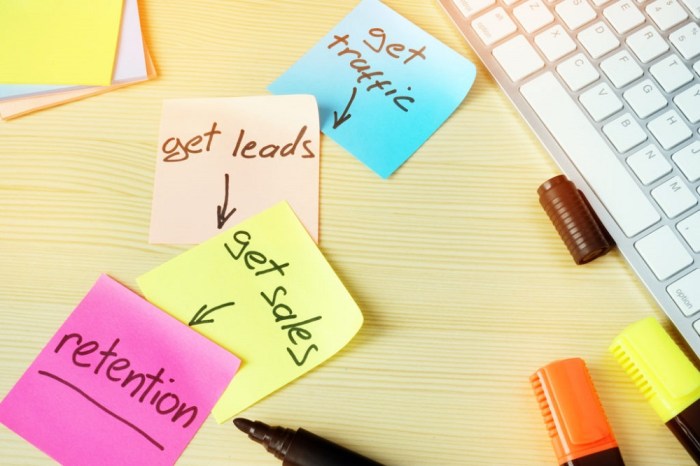Understanding Customer Retention takes center stage in the business world, where keeping customers engaged and loyal is key. From the importance of retention to effective communication strategies, this topic delves into the elements that drive customer loyalty and revenue growth. Get ready to explore a world of customer-centric strategies that are essential for any thriving business.
Get ready to dive into the essentials of customer retention and discover how businesses can thrive by keeping their customers happy and engaged.
Importance of Customer Retention

Customer retention is a critical component of business success, as it involves keeping existing customers engaged and satisfied, ultimately leading to increased revenue and growth. By focusing on retaining customers, businesses can build long-term relationships, boost brand loyalty, and drive repeat purchases.
Impact on Revenue
Customer retention has a direct impact on revenue generation for businesses. Here are some examples of how customer retention influences the financial success of a company:
- Increased Customer Lifetime Value: Retained customers tend to spend more over time, leading to higher overall revenue for the business.
- Cost Savings: Acquiring new customers can be expensive, so investing in retaining existing customers can be a cost-effective strategy to maximize profits.
- Word-of-Mouth Marketing: Satisfied customers are more likely to recommend the business to others, leading to new customer acquisitions and revenue growth.
Strategies for Improving Customer Retention
To enhance customer retention and drive business growth, consider implementing the following strategies:
- Personalized Customer Experiences: Tailor your products or services to meet the individual needs and preferences of your customers, enhancing their overall satisfaction.
- Effective Communication: Stay in touch with your customers through various channels, such as email, social media, or personalized messages, to keep them engaged and informed.
- Reward Loyalty: Offer loyalty programs, discounts, or exclusive perks to incentivize repeat purchases and show appreciation for customer loyalty.
- Solicit Feedback: Regularly collect feedback from customers to understand their needs, preferences, and pain points, allowing you to make improvements and enhance customer satisfaction.
Understanding Customer Behavior: Understanding Customer Retention

Customer behavior is a crucial aspect to consider when aiming to retain customers. By understanding how customers think and act, businesses can tailor their strategies to meet their needs and keep them coming back for more.
Key Factors Influencing Customer Loyalty
- Quality of Product or Service: Customers are more likely to stay loyal if they are satisfied with what they are receiving.
- Customer Service: Providing excellent customer service can build trust and loyalty among customers.
- Personalization: Tailoring products or services to individual customers can create a sense of value and loyalty.
- Rewards and Incentives: Offering rewards or incentives for repeat purchases can encourage customer loyalty.
Role of Data Analysis in Understanding Customer Behavior
Data analysis plays a significant role in understanding customer behavior by providing valuable insights into customer preferences, buying patterns, and feedback. By analyzing data, businesses can identify trends, anticipate customer needs, and make data-driven decisions to enhance customer retention strategies.
Effective Communication Strategies
Effective communication plays a crucial role in customer retention as it helps in building strong relationships with customers. By understanding their needs and preferences, businesses can tailor their communication strategies to enhance customer satisfaction and loyalty.
Personalized Communication Methods
- Send personalized emails addressing customers by their names and offering relevant product recommendations based on their purchase history.
- Utilize SMS or messaging apps to send personalized messages such as order updates, exclusive offers, or birthday greetings.
- Implement personalized chatbots on websites to provide real-time assistance and personalized recommendations to customers.
Omni-channel Communication
Omni-channel communication involves interacting with customers through multiple channels such as email, social media, phone calls, and in-person interactions. This approach allows businesses to engage with customers seamlessly across various touchpoints, providing a consistent and personalized experience.
By adopting omni-channel communication, businesses can ensure that customers receive relevant information and support through their preferred channels, leading to increased satisfaction and loyalty.
Building Customer Loyalty Programs
Building Customer Loyalty Programs is essential for businesses looking to retain customers and increase customer lifetime value. Loyalty programs offer various benefits in retaining customers, such as incentivizing repeat purchases, creating brand advocates, and fostering long-term relationships with customers.
Benefits of Loyalty Programs
- Encourages repeat purchases: Loyalty programs reward customers for their continued business, encouraging them to make repeat purchases to earn rewards or discounts.
- Creates brand advocates: Satisfied customers who benefit from loyalty programs are more likely to recommend the brand to others, leading to word-of-mouth marketing and increased customer acquisition.
- Builds long-term relationships: By offering personalized rewards and incentives, loyalty programs help businesses build strong, long-term relationships with customers, increasing customer retention rates.
Examples of Successful Loyalty Programs
- Starbucks Rewards: Starbucks’ loyalty program offers customers points for every purchase, which can be redeemed for free drinks or food items, creating a sense of exclusivity and rewarding frequent customers.
- Amazon Prime: Amazon’s loyalty program, Amazon Prime, provides members with free shipping, exclusive deals, and access to streaming services, incentivizing customers to make more purchases on the platform.
Designing Tailored Loyalty Programs
- Segment customers based on behavior: Design loyalty programs tailored to different customer segments by analyzing purchase history, preferences, and demographics to offer personalized rewards and incentives.
- Offer multiple reward options: Provide customers with a variety of reward options, such as discounts, free products, or exclusive experiences, to cater to different preferences and increase engagement.
- Promote exclusivity: Create a sense of exclusivity by offering tiered loyalty programs with increasing benefits based on customer loyalty, encouraging customers to reach higher levels for greater rewards.
Handling Customer Feedback
Customer feedback is a crucial aspect of any business as it provides valuable insights into the customer experience. By collecting and acting on feedback, companies can improve their products and services, resolve issues promptly, and build stronger relationships with their customers.
Significance of Customer Feedback
Customer feedback helps businesses understand what their customers think about their products or services. It allows companies to identify areas for improvement, address customer concerns, and enhance overall customer satisfaction. By listening to feedback, businesses can demonstrate that they value their customers’ opinions and are committed to providing a positive experience.
- Regularly collect feedback through surveys, reviews, and social media to gather a variety of perspectives.
- Act promptly on feedback by addressing concerns, implementing suggestions, and communicating changes to customers.
- Use feedback as a tool for continuous improvement, driving innovation, and enhancing customer loyalty.
Best Practices for Managing Customer Feedback
Managing customer feedback effectively involves establishing clear processes for collecting, analyzing, and responding to feedback. Companies should designate specific team members to monitor feedback channels, categorize feedback, and prioritize actions based on severity and frequency.
- Acknowledge and thank customers for their feedback to show appreciation for their input.
- Respond promptly to customer feedback, even if it is negative, to demonstrate attentiveness and a commitment to resolving issues.
- Personalize responses by addressing customers by name and tailoring solutions to their specific concerns.
Feedback Loops for Improving Customer Retention
Feedback loops involve continuously collecting and acting on customer feedback to drive meaningful changes that enhance the customer experience. By closing the feedback loop with customers, companies can show that they are actively listening, taking action, and prioritizing customer satisfaction.
Implement feedback mechanisms that allow customers to see how their feedback has influenced changes or improvements in products or services.
| By incorporating feedback loops into customer retention strategies, businesses can: |
| – Strengthen customer relationships |
| – Increase customer loyalty |
| – Differentiate themselves from competitors |
Utilizing Technology for Retention
Technology plays a crucial role in enhancing customer retention efforts in today’s digital age. By leveraging various software and tools, businesses can better understand their customers, communicate effectively, and build lasting relationships. Let’s explore how technology can revolutionize customer retention strategies.
Customer Retention Software and Tools
- Customer Relationship Management (CRM) software: CRM platforms like Salesforce, HubSpot, and Zoho CRM help businesses manage customer interactions, track leads, and personalize communication.
- Marketing Automation tools: Tools such as Marketo, Pardot, and Mailchimp enable businesses to automate marketing campaigns, send targeted messages, and nurture customer relationships.
- Feedback and Survey tools: Platforms like SurveyMonkey, Typeform, and Google Forms allow businesses to collect valuable feedback from customers, analyze responses, and make data-driven decisions.
Role of AI and Automation, Understanding Customer Retention
- AI-powered chatbots: Chatbots can provide instant customer support, answer queries, and guide customers through the sales process, improving overall customer experience.
- Predictive analytics: AI algorithms can analyze customer data to predict behavior, identify trends, and personalize recommendations, leading to increased customer satisfaction and loyalty.
- Automated personalized messaging: Automation tools can send personalized messages, offers, and recommendations based on customer preferences and behavior, creating a more personalized and engaging experience.
